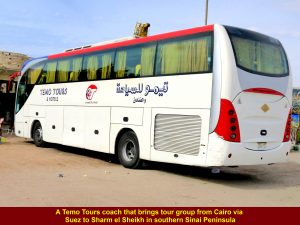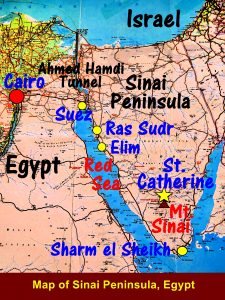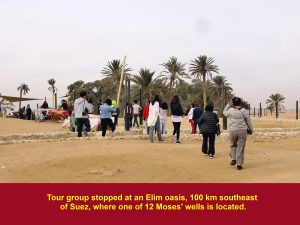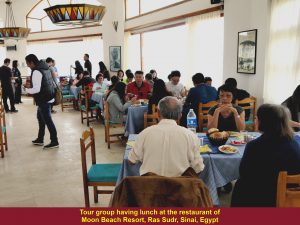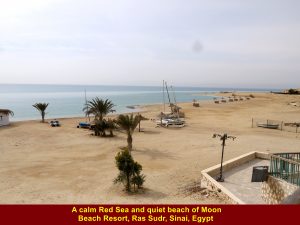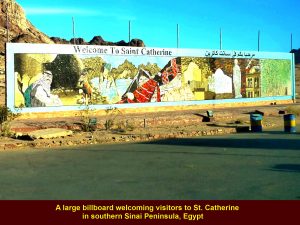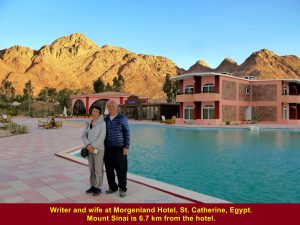Egypt Travel Part VIII: Ahmed Hamdi Tunnel, Moon Beach(Ras Sudr) and St. Catherine
Egypt Travel Part VIII: Ahmed Hamdi Tunnel, Moon Beach(Ras Sudr) and St. Catherine
Day 7 Tuesday, 19 Dec 2017
Early in the morning, we left Cairo and would be on a long journey on the road by coach to St. Catherine and then to Sharm el Sheikh in Sinai Peninsula, Egypt.
Coach bringing tour group from Cairo to Sinai Peninsula
Map showing the places with names in blue in Sinai Peninsula the tour group were going to stop or visit
Ahmed Hamdi Tunnel
To go to Sinai Peninsula from Cairo our coach had to go through a tunnel under the Suez Canal. Known as Ahmed Hamdi Tunnel it is about 1.63 km long and about 120 km east of Cairo. It was opened in 1981 and reopened in 1992.
A place near the entrance of Ahmed Hamdi Tunnel from Suez to Sinai Peninsula
Part of the Ahmed Hamdi Tunnel as seen from the writer’s moving coach.
Sinai Peninsula is a desert area with very little vegetation and rain. The roads were straight and looked new.
Moses’ well in Elim
On the way to St. Catherine we stopped at a place, Elim, which is 100 km south-east of the tunnel in Suez. There was a well in its oasis. It was one of the 12 wells used by Prophet Moses and his followers, Israelites, who were on their way to the promised land.
Moses crossed the Red Sea
According to the Book of Exodus, Moses led Israelites to escape from the ancient Egyptian army. They then crossed the Red Sea parted by God to a promised land in Sinai Peninsula.
On the way to the promised land, they stopped at several wells. One of them was at in the Elim oasis.
A painting showing Moses leading Israelites across the Red Sea parted by God to a promised land in Sinai Peninsula. They were being pursued by their enemies, the ancient Egyptian army.
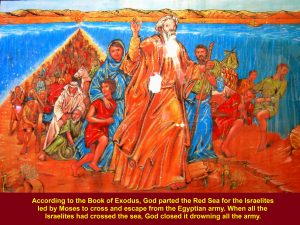
Moses leading Israelites and crossing the Red Sea parted by God to escape from the ancient Egyptian army, according to the Book of Exodus.
Tour group stopped at Elim which is 100 km south-east of Suez to see one of the 12 Moses’ wells in the oasis.
The Israelites led by Moses stopped and camped at the well for a short while before they continued their journey to the promised land, according to the Book of Exodus.

One of 12 Moses’ wells in Elim where the Israelites led by Moses stopped and camped there for a while
Unoccupied Houses
On the journey in northern Sinai Peninsula, we noticed many houses were unoccupied by civilians. It was due to Sinai insurgency between the Islamist militants and the Egyptian security forces. Besides, the civilians were afraid of being attacked by the militants.
Unoccupied houses by civilians along highways in northern Sinai Peninsula

Unoccupied houses by civilians along highways in northern Sinai Peninsula due to Sinai insurgency, and civilian attacks by the militants
Lunch at Moon Beach Resort Restaurant, Ras Sudr
Tour group stopped at Moon Beach Resort Restaurant, Ras Sudr, for lunch after travelling 226 km by road from Cairo.

Tour group stopping at Moon Beach Resort Restaurant, Ras Sudr. for lunch after travelling 226 km by road from Cairo
Lunch in dining hall of Moon Beach Restaurant, Ras Sudr
Calm Red Sea and quiet beach of Moon Beach Resort, Ras Sudr, Sinai Peninsula, Egypt
Leaving Ras Sudr after lunch
After lunch we left Ras Sudr and travelled another 200 km to St. Catherine. But two hours later, we stopped at a roadside cafe for tea-break.
Tea-break at a roadside cafe.
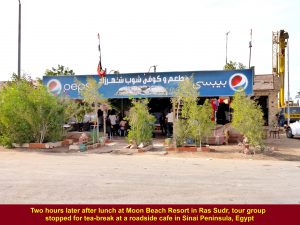
Tour group stopping at a roadside cafe for tea-break after having lunch at Ras Sudr about two hours ago
Tour group relaxing at a roadside cafe for a short while before they continued their journey to St. Catherine in the south.
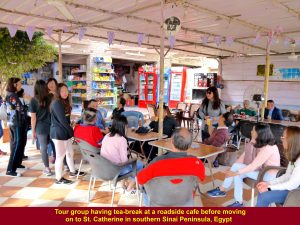
Tour group having a drink and relaxing at the roadside cafe before going to St. Catherine in the south
Egypt-Israel Peace Treaty(1979)
Sinai Peninsula was occupied by the Israeli forces from 1967 until 1982. It was returned to Egypt in 1982 although the Peace Treaty between them was signed in 1979.
Sinai Peninsula was occupied by Israeli forces from 1967 until 1982.
Arrival at St. Catherine
After a long journey from Cairo via the Suez tunnel, we finally reached St. Catherine in Sinai Peninsula. We had travelled a total distance of abou 440 km on the road from Cairo to St. Catherine during the whole day.
We would stay at a hotel, Morgenland Hotel, for a night. But some of us would leave the place after midnight and travelled 6.7 km to the foot of a mountain, Mount Sinai, which is 2285 metres above sea-level and then climbed up the mountain to its peak in pitch-darkness.
A large billboard welcoming visitors to St. Catherine in South Sinai Peninsula, Egypt
Tour group resting at Morgenland Hotel at St. Catherine before climbing Mount Sinai(2285 metres) after midnight.
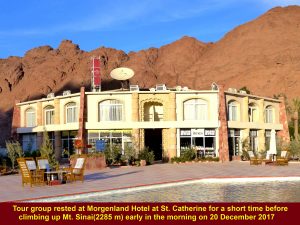
Tour group resting at Morgenland Hotel at St. Catherine before climbing Mount Sinai(2285 metres) which is 6.7 km away after midnight
Writer and wife at Morgenland Hotel, St. Catherine, on 19 Dec 2017
Moses received the Ten Commandments on Mt. Sinai
According to the Book of Exodus, Moses went up Mt. Sinai to receive two tablets of stone inscribed with the God’s Ten Commandments.
Mount Sinai, a tourists’ popular site

Mt. Sinai attracts tourists as, according to the Book of Exodus, Moses had gone up to receive two tablets of stone inscribed with the God’s Ten Commandments
Writer getting ready to climb Mt. Sinai with other tour members after midnight on 20 Dec 2017
(Continue in Egypt Travel Part IX)
Egypt Travel Parts I to XII
Egypt Travel Part I :Salah el Din Citadel, Muhammad Ali Mosque, Tahrir Square and Egyptian Museum
Egypt Travel Part II :Valley of the Kings, Hatshepsut Temple and Colossi of Memnon
Egypt Travel Part III :Hot Air Balloons and Karnak Temple Complex
Egypt Travel Part IV :Papyrus Paper-Making, Luxor Temple and Esna Lock
Egypt Travel Part V :Edfu Temple, Kom Ombo Temple and Galabia Party
Egypt Travel Part VI :Abu Simbel Temples and Nubian Village(Elephantine Island)
Egypt Travel Part VII :Unfinished Obelisk, Aswan High Dam and Philae Temple
Egypt Travel Part VIII:Ahmed Hamdi Tunnel, Moon Beach(Ras Sudr), and St. Catherine
Egypt Travel Part IX :Mount Sinai, Catherine’s Monastery and Sharm el Sheikh
Egypt Travel Part X :Sharm el Sheikh
Egypt Travel Part XI :Cairo Food, Saqqara Step Pyramid Complex and Memphis
Egypt Travel Part XII :Great Giza Pyramid Complex and Khan el Khalil Bazaar
Comments
Tell me what you're thinking...
and oh, if you want a pic to show with your comment, go get a gravatar!

